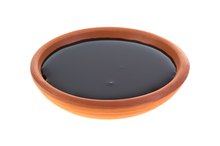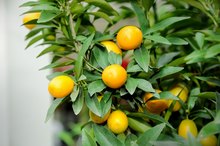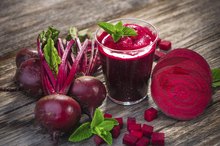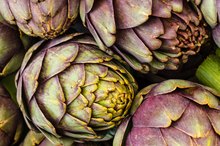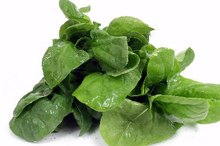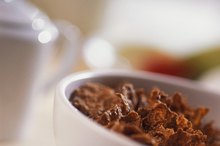What does fact checked mean?
At Healthfully, we strive to deliver objective content that is accurate and up-to-date. Our team periodically reviews articles in order to ensure content quality. The sources cited below consist of evidence from peer-reviewed journals, prominent medical organizations, academic associations, and government data.
The information contained on this site is for informational purposes only, and should not be used as a substitute for the advice of a professional health care provider. Please check with the appropriate physician regarding health questions and concerns. Although we strive to deliver accurate and up-to-date information, no guarantee to that effect is made.
Soluble Fiber & Beets
Grains, fruits and vegetables, including beets, are sources of the dietary fiber that promotes your overall health. The sugar, water, vitamins and minerals from beets are absorbed through the walls of your intestines into your bloodstream. Your body can’t digest or absorb the fiber from the beets, so these complex carbohydrates stay inside your intestines to serve other functions. Beets and many other vegetables contain both soluble and insoluble forms of fiber.
Fiber Content
A 1/2-cup serving of sliced beets contains 1.7 g of total fiber, including 0.7 g of soluble fiber. Soluble fiber from inside the beet plant cells dissolves in water within your intestines. The American Heart Association also emphasizes the importance of beets as a food high in insoluble fiber 3. Insoluble fiber that comes from the cell walls of beets doesn’t combine with water. Instead, it provides roughage that promotes normal bowel function.
- A 1/2-cup serving of sliced beets contains 1.7 g of total fiber, including 0.7 g of soluble fiber.
- Insoluble fiber that comes from the cell walls of beets doesn’t combine with water.
Soluble Fiber Effect
How to Make Molasses With Sugar Beets
Learn More
The soluble fiber from beets dissolves in water within your intestines and combines with bile acids to form a gel-like substance that’s excreted from your body in your stools. When your liver identifies a drop in bile acid levels, it pulls some cholesterol from storage areas within the liver to create more bile acids. When liver stores of cholesterol drop, the liver pulls more cholesterol from the blood flowing through it and uses that cholesterol to replace lost stores. The level of both total cholesterol and low-density lipoproteins, or bad cholesterol, in your blood drops, lowering your risk factors for coronary artery disease.
- The soluble fiber from beets dissolves in water within your intestines and combines with bile acids to form a gel-like substance that’s excreted from your body in your stools.
- When your liver identifies a drop in bile acid levels, it pulls some cholesterol from storage areas within the liver to create more bile acids.
Insoluble Fiber Effect
The insoluble fiber from beets stays inside your intestines, where it forms larger, softer stools that pass easily through your digestive tract. You can have a bowel movement without straining, which reduces your risk of developing chronic constipation, hemorrhoids, diverticulosis or diverticulitis.
Boosting Fiber Intake
What Is the Nutritional Value of Beets?
Learn More
With 1.7 g of total fiber per serving, beets don’t meet the criteria of 2.5 to 4 g per serving which constitutes a good source of fiber. Add beets to a colorful salad that contains cooked barley, oranges, strawberries and apples to boost the soluble fiber content. You can also add ingredients rich in insoluble fiber, such as dark leafy greens, nuts and cruciferous vegetables, including broccoli and cauliflower.
Related Articles
References
- Continuum Health Partners: Bowel Function & Fiber
- U.S. Department of Agriculture: National Nutrient Database
- American Heart Association: Cholesterol, Fiber and Oat Bran
- Beets, raw. FoodData Central. U.S. Department of Agriculture. Published April 1, 2019.
- Sawicki T, Bączek N, Wiczkowski W. Betalain profile, content and antioxidant capacity of red beetroot dependent on the genotype and root part. J Funct Foods. 2016;27:249-261. doi:10.1016/j.jff.2016.09.004
- Domínguez R, Cuenca E, Maté-Muñoz JL, et al. Effects of beetroot juice supplementation on cardiorespiratory endurance in athletes. A systematic review. Nutrients. 2017;9(1). doi:10.3390/nu9010043
- Kapil V, Khambata RS, Robertson A, Caulfield MJ, Ahluwalia A. Dietary nitrate provides sustained blood pressure lowering in hypertensive patients: A randomized, phase 2, double-blind, placebo-controlled study. Hypertension. 2015;65(2):320-7. doi:10.1161/HYPERTENSIONAHA.114.04675
- Presley TD, Morgan AR, Bechtold E, et al. Acute effect of a high nitrate diet on brain perfusion in older adults. Nitric Oxide. 2011;24(1):34-42. doi:10.1016/j.niox.2010.10.002
- Gilchrist M, Winyard PG, Fulford J, Anning C, Shore AC, Benjamin N. Dietary nitrate supplementation improves reaction time in type 2 diabetes: Development and application of a novel nitrate-depleted beetroot juice placebo. Nitric Oxide. 2014;40:67-74. doi:10.1016/j.niox.2014.05.003
- Lopes de Oliveira LC, Genov IR, Cabral EDC, MF Mello YA, Mallozi MC, Solé D. Anaphylaxis to beetroot (Beta vulgaris): A case report. Clin Transl Allergy. 2011;1(Suppl 1):P51. doi:10.1186/2045-7022-1-S1-P51
- Getting JE, Gregoire JR, Phul A, Kasten MJ. Oxalate nephropathy due to 'juicing': Case report and review. Am J Med. 2013;126(9):768-72. doi:10.1016/j.amjmed.2013.03.019
- Beets, cooked, boiled. FoodData Central. U.S. Department of Agriculture. Published April 1, 2019.
- Beets, canned. FoodData Central. U.S. Department of Agriculture. Published April 1, 2019.
- Beets, pickled. FoodData Central. U.S. Department of Agriculture. Published April 1, 2019.
Resources
Writer Bio
Sandy Keefe, M.S.N., R.N., has been a freelance writer for over five years. Her articles have appeared in numerous health-related magazines, including "Advance for Nurses" and "Advance for Long-Term Care Management." She has written short stories in anthologies such as "A Cup of Comfort for Parents of Children with Special Needs."
